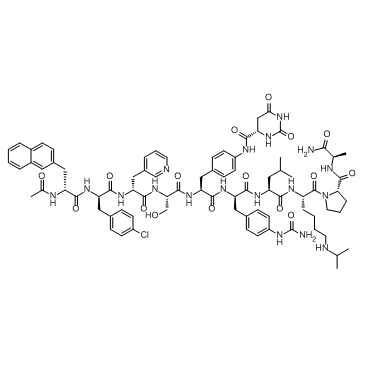| Description |
Degarelix is a competitive and reversible gonadotropin-releasing hormone receptor (GnRHR) antagonist.
|
| Related Catalog |
|
| Target |
GnRHR[1]
|
| In Vitro |
Degarelix acts directly on the pituitary receptors for luteinizing hormone-releasing hormone (LHRH), blocking the action of endogenous LHRH. The use of degarelix eliminates the initial undesirable surge in gonadotropin and testosterone levels, which is produced by agonists of LHRH[1]. Degarelix treatment reduces cell viability in all prostate cell lines (WPE1-NA22, WPMY-1, BPH-1 cells, VCaP cells), with the exception of the PC-3 cells. The GnRH antagonist degarelix exerts a direct effect on prostate cell growth through apoptosis[2].
|
| In Vivo |
At single subcutaneous injections of 0.3 to 10 μg/kg in rats, degarelix produces a dose-dependent suppression of the pituitary-gonadal axis as revealed by the decrease in plasma luteinizing hormone (LH) and testosterone levels. Duration of LH suppression increases with the dose: in the rat, significant suppression of LH lasted 1, 2, and 7 days after a single subcutaneous injection of degarelix at 12.5, 50, or 200 μg/kg, respectively[3]. Degarelix is stable when incubated in microsomes and cryopreserved hepatocytes from animal liver tissue. In rat and dog, most of the degarelix dose is eliminated within 48 h via urine and feces in equal amounts (40–50% in each matrix), whereas in monkey the major route of excretion is fecal (50%) and renal (22%)[4].
|
| Cell Assay |
Cells are allowed to attach for 24–48 hours (h). After that, they are treated with different concentrations of degarelix, a GnRH antagonist (0.1 to 10 μM). 10 μL of MTT labeling reagent is added to each well and the plates are incubated at 37°C for 4h. Then, 100 μL of solubilization solution is added, and the plates are incubated at 37°C, overnight, in a humidified atmosphere. The final reaction is measured at 550–600 nm. The obtained absorbance directly correlates to the number of live and metabolically active cells, providing an indication of cell viability[2].
|
| Animal Admin |
Rats: To study the absorption, distribution, metabolism, and excretion, male and female rats are dosed with 30 μg [3H]degarelix free base peptide/kg (-300 μCi/kg). Feces, heparin plasma, and urine samples from groups A and B are collected up to 240 h after dosing. Bile sampling from cannulated rats (group C) as well as urine and feces are collected for up to 48 h. All samples in this study are analyzed by LC-RAD at the contract research[4]. Monkeys: Four male cynomolgus Monkeys (4.2-7.5 kg) are dosed for a disposition of radioactivity study. The animals are administered a single subcutaneous dose of 8.2 μg/kg (200 μCi/kg) [3H]degarelix. Urine and feces samples are collected quantitatively from each animal after dosing until the time of sacrifice. Blood samples are collected at the time of the sacrifice of the individual animal (6, 24, 48, and 240 h) into tubes containing EDTA as an anticoagulant[4].
|
| References |
[1]. Rick FG, et al. An update on the use of degarelix in the treatment of advanced hormone-dependent prostate cancer. Onco Targets Ther. 2013 Apr 16;6:391-402. [2]. Sakai M, et al. In search of the molecular mechanisms mediating the inhibitory effect of the GnRH antagonistdegarelix on human prostate cell growth. PLoS One. 2015 Mar 26;10(3):e0120670. [3]. Broqua P, et al. Pharmacological profile of a new, potent, and long-acting gonadotropin-releasing hormoneantagonist: degarelix. J Pharmacol Exp Ther. 2002 Apr;301(1):95-102. [4]. Sonesson A, et al. Metabolite profiles of degarelix, a new gonadotropin-releasing hormone receptor antagonist, in rat, dog, and monkey. Drug Metab Dispos. 2011 Oct;39(10):1895-903.
|
